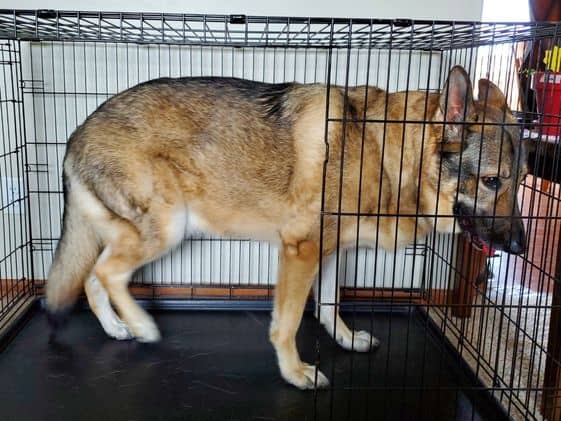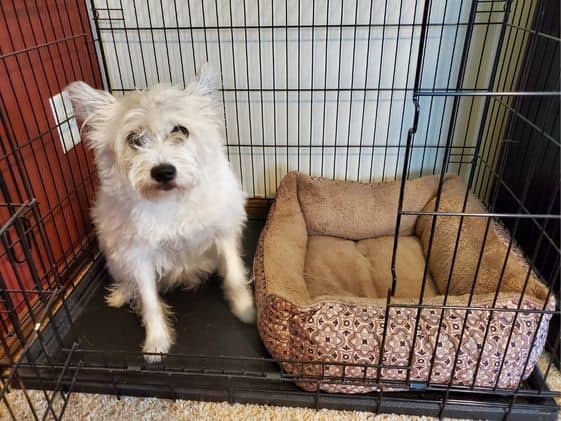Last Updated on November 17, 2023 by Shannon
You want the best for your furry friend, but you don’t know where to start when it comes to choosing a dog crate.
There are so many different kinds of crates on the market, and it can be tough to figure out which one is right for your pup.
This blog post will help you learn about the different types of crates available and how to choose the right one for your dog’s needs.
This post may contain affiliate links. That means if you click on them and buy something, I may receive a small commission at no cost to you. Read my Disclaimer Policy to learn more.
How to choose the right crate for your dog
When it comes to dog crates, there are a lot of options out there. From wire crates to dog crate furniture, how do you know which one is right for your pup?
Here are some things to consider when choosing a crate for your dog:
Consider your needs
The first thing you need to do when choosing a crate for your dog is to consider your needs. Are you looking for a crate to use while traveling? Or do you need something for your dog to sleep in at night? Or are you just wanting it to help with potty training your puppy?
There are different types of crates available for different needs.
Crate size matters

Once you’ve decided what you need the crate to do, the next step is to choose the right size. This is important because you want your dog to have enough space in their crate.
If the crate is too small, like the one in the above picture, they won’t be able to move around and stretch out. And if it’s too big, they might be able to use one corner as a bathroom.
The best way to find the right crate for your dog’s size is to measure them. First, measure from the tip of the nose to the base of the tail. This will give you an idea of how long the crate should be.
Then, measure from the top of his head to the ground to get your dog’s height. This will tell you how tall the crate should be.
Consider your dog’s full-grown size

If you are buying a crate for a new puppy, you want to consider their adult size when picking the crate size. If you get the right size dog crate for your dog as an adult, you shouldn’t need to buy another one.
You don’t want to do what I had to do for Luna, buy 3 different crates because she grew so much. Granted the first one I knew she would outgrow, but no one was around at the store to answer my questions so I got the one I knew would work for the next few weeks.
Depending on your type of crate, it can “grow” with your puppy. Some crates come with divider panels that you can use to make the crate smaller while your puppy is still potty training. You can move the divider as your puppy grows and eventually remove it.
Easy Cleaning is a Must
No matter the age of your dog, you at one point or another end up having to clean the crate. This is more likely with a potty-training puppy, but any age dog will eventually have a dirty kennel (even if it’s just mud from outside).
Make cleaning the crate easier on yourself and get one that is easy to clean. Wire crates usually have a removable plastic tray. Many plastic crates can be taken apart for cleaning.
No matter which crate you choose, make sure there is a way to clean it.
What does your dog like?
Another thing to think about when choosing your dog’s crate is what they like. If your dog enjoys being in a cave-like den, a more solid, plastic crate may be better for them. If they like to watch everything around them, a more open, wire crate may be the best choice.
Crate types
Now that you know what to look for when choosing a crate, let’s take a look at the different types of crates available.
Plastic Crates
Plastic dog crates are a good choice if you are looking for something more solid and den-like for your dog.
These crates are often used for air travel because they provide more of a secure feeling for your dog. They also have a handle on the top which makes it easier to lift while traveling.
The downside to plastic crates is that they can be more difficult to clean than wire crates. And, some dogs may find them too confining.
Wire Crates

A wire dog crate, or a metal dog crate, is the best option if you are looking for something more open. Many wire crates have a double door that allows your dog to enter on one of two sides of the crate.
They also often have a removable pan that makes them easier to clean. And, many wire crates come with a crate divider so you can make the crate smaller for a puppy and then remove it as they grow.
Wire crates also take up less room than plastic crates when they are not in use. Most wire crates are collapsible and will easily fit under a bed for storage.
The downside to wire crates is that some dogs may feel too exposed in them. And, they are not as good for traveling with your dog in a car or on an airplane.
Soft-sided or fabric crates
Soft-sided and fabric dog crates are good choices for those wanting a more portable crate. They are light and usually can be folded up quite easily.
The downside of soft-sided and fabric crates is that many dogs are able to damage these crates fairly easily by scratching them or chewing on them.
This type of crate is also best for a small dog and the largest crate available may not be big enough for the size of your dog if they are a larger breed.
Wood crates
Wood dog crates, or furniture-style dog crates, are not as popular as they once were. But, you may still see them around. The advantage of this style of crate is that you can use it as an end table or tv stand instead of losing that space to a dog crate.
The downside of wood crates is that they can be very heavy and difficult to move. They are also often more expensive than other types of crates.
Most importantly, wood crates are hard to escape-proof for dogs that are determined to get out. If you have a dog that is a known escape artist, a wood crate may not be the best choice for them.
Heavy-duty dog crates
If you have especially strong or anxious dogs, you may need a heavy-duty dog crate. These crates are made of thicker wire and often have more than one door.
The downside of heavy-duty crates is that they can be very expensive. They are also often too large and bulky to be used in a car or on an airplane.
What do Luna and Morgan use?

I currently use wire crates for Morgan and Luna. Luna went through multiple crates before getting to the one she is in now. The first we bought the day we got Luna and I knew it wouldn’t last very long. I wanted a larger crate with a divider, but there were no salespeople around and I was in a hurry so I bought the size that would work that day.
Once she outgrew it, I went to a different store and bought the one that said it should work for her adult size. Since it had a divider, I was able to make it the size she needed then and she could grow into it. Unfortunately, she got bigger than I expected (my research at the time only gave me breed standard, not max variation).
I went back to the store and bought the next bigger crate as that was the biggest size they had that day. Unfortunately, even that one was too small for my puppy that wouldn’t stop growing.
Finally, I bought the biggest crate they had once it was in stock. This large crate barely fits in my car with the seats down. I can’t take it anywhere if I need to take my kids as well. But it fits her, sort of.
Luna can’t stand completely upright in her crate, she has to keep her head slightly down, but she can stand in it. Her back is near the top but doesn’t quite touch it. Thankfully she doesn’t spend much time in there.
She mostly goes in when she wants, and when we do have to tell her to go in, it’s usually just for a few minutes. Unfortunately, it’s the biggest they sell and it barely fits in my living room the way it is.

Morgan started in a plastic crate and used that happily for several years until Luna had outgrown her second crate.
Once we had an extra crate that was bigger than what Morgan had, we decided to switch her to the wire crate to give her some more space. Now she has enough room for a dog bed and room to lay on the plastic tray when she wants to.
Dog Crate Accessories
No matter what kind of crate you decide on, there are a few crate accessories that can make your pup more comfortable.
Crate Covers
A crate cover can help your dog feel more secure in their crate. It also helps to reduce the amount of visual stimulus coming in, which can make some dogs less anxious.
Crate mats or pads
A crate mat or pad can make the floor of the crate more comfortable for your dog to lay on. Some dogs like having something to lay on, but others prefer to not have anything in their crate.
What about exercise pens?
An exercise pen is not a crate, but it can serve a similar purpose. Exercise pens are usually made of metal or plastic and have panels that you can attach to each other to create a fenced-in area.
They are often used to give dogs a safe place to play outside or to contain them inside the house. Many people use these when they want to give a new puppy more freedom in the house but aren’t ready to give the puppy free roam.
The main downside of exercise pens is that they are not very sturdy and can be knocked over by a determined dog. They are also not very portable, so they are not a good option for traveling.
Conclusion
So, what are the best dog crates? It depends on your dog and their size, strength, and determination! If you have a dog from one of the many small breeds that is not determined to escape, a fabric crate should be fine. If you have one of the many large breeds of dogs that is strong or determined to get out of their crate, you may need a heavy-duty crate.
The best crate for your dog is one that best fits their size and temperament. What works for one dog may not work for another.
Good luck and enjoy your new family member!
Related Posts
How To Crate Train Your New Puppy
How To Survive The First 48 Hours With A New Puppy
Common Dog House Training Questions






Interesting article. Well worth considering.